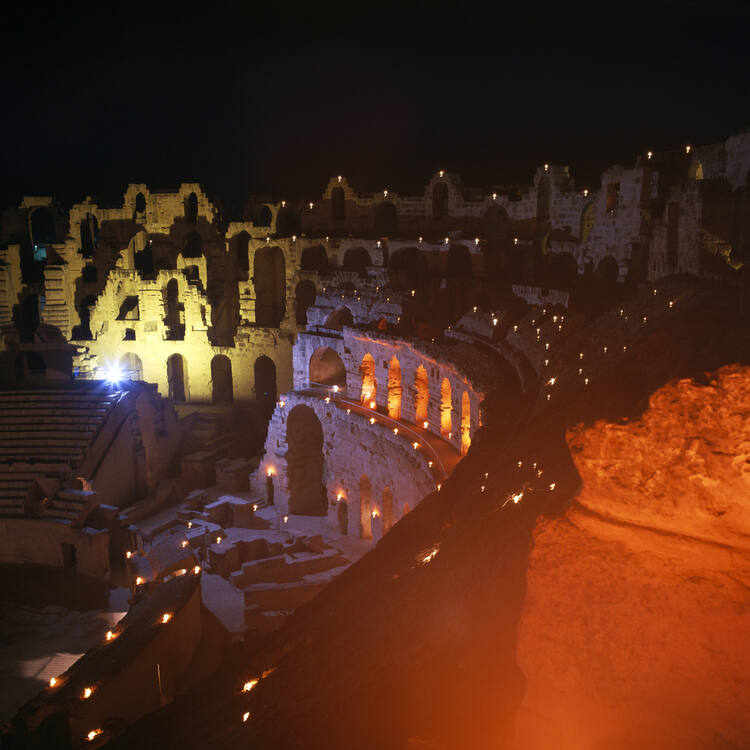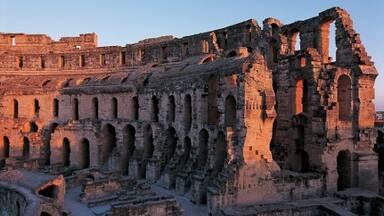Amphitheatre of El Jem
Amphitheatre of El Jem
The impressive ruins of the largest colosseum in North Africa, a huge amphitheatre which could hold up to 35,000 spectators, are found in the small village of El Jem. This 3rd-century monument illustrates the grandeur and extent of Imperial Rome.
Description is available under license CC-BY-SA IGO 3.0
Amphithéâtre d'El Jem
Dans la petite bourgade d'El Jem s'élèvent les ruines impressionnantes du plus grand colisée d'Afrique du Nord, immense amphithéâtre où pouvaient prendre place 35 000 spectateurs. Cette construction du IIIe siècle illustre l'extension et la grandeur de l'Empire romain.
Description is available under license CC-BY-SA IGO 3.0
مدرّج الجم الروماني
ترتفع في مدينة الجم الصغيرة الآثار المهيبة لأكبر كوليزيه في شمال افريقيا وهو عبارة عن مدرّج روماني ضخم يتسع لما يعادل 35000 مشاهد. ويجسّد هذا البناء العائد الى القرن الثالث توسع الامبراطورية الرومانية وعظمتها.
source: UNESCO/CPE
Description is available under license CC-BY-SA IGO 3.0
杰姆的圆形竞技场
该遗址是北非最大的竞技场遗址,其规模令人叹为观止。该竞技场坐落在一个叫杰姆的小村子里,能够容纳35 000名观众。这座始建于3世纪的建筑展示了罗马帝国的庄严和庞大。
source: UNESCO/CPE
Description is available under license CC-BY-SA IGO 3.0
Амфитеатр в Эль-Джеме
Внушительные руины крупнейшего в Северной Африке амфитеатра, который мог вмещать до 35 тыс. зрителей, обнаружены в небольшом поселении Эль-Джем. Этот памятник III в. иллюстрирует великолепие Римской империи и масштабы ее влияния.
source: UNESCO/CPE
Description is available under license CC-BY-SA IGO 3.0
Anfiteatro de El Jem
En el pequeño pueblo de El Jem se alzan las ruinas impresionantes del más célebre coliseo romano de África del Norte, un inmenso anfiteatro con cabida para unos 35.000 espectadores. Esta construcción del siglo III es ilustrativa de la expansión y grandeza del Imperio Romano.
source: UNESCO/CPE
Description is available under license CC-BY-SA IGO 3.0
エル・ジェムの円形闘技場
source: NFUAJ
Amfitheater El Jem
Source: unesco.nl
Outstanding Universal Value
Brief synthesis
The Amphitheatre of El Jem bears outstanding witness to Roman architecture, notably monuments built for spectator events, in Africa. Located in a plain in the centre of Tunisia, this amphitheatre is built entirely of stone blocks, with no foundations and free-standing. In this respect it is modelled on the Coliseum of Rome without being an exact copy of the Flavian construction. Its size (big axis of 148 metres and small axis 122 metres) and its capacity (judged to be 35,000 spectators) make it without a doubt among the largest amphitheatres in the world. Its facade comprises three levels of arcades of Corinthian or composite style. Inside, the monument has conserved most of the supporting infrastructure for the tiered seating. The wall of the podium, the arena and the underground passages are practically intact. This architectural and artistic creation built around 238 AD, constitutes an important milestone in the comprehension of the history of Roman Africa. The Amphitheatre of El Jem also bears witness to the prosperity of the small city of Thysdrus (current El Jem) at the time of the Roman Empire.
Criterion (iv): The Amphitheatre of El Jem is one of the rare monuments of its kind and unique in Africa, which is not built against a hillside, but on flat ground and supported by a complex system of arches. The monument of El Jem is one of the most accomplished examples of Roman architecture of an amphitheatre, almost equal to that of the Coliseum of Rome.
Criterion (vi): The construction in a far-off province of a sophisticated and complex building, designed for popular spectacles, is characteristic of imperial Roman propaganda.
Integrity (2009)
The monument has conserved, without alteration, most of its architectural and architectonic components.
Authenticity (2009)
Restoration work carried out over time has not affected the essential functional and structural authenticity of the property. The authenticity of the setting is however threatened by the appearance of new constructions around the amphitheatre.
Protection and management requirements (2009)
The Amphitheatre of El Jem is protected by the Law 35-1994 concerning the protection of archaeological and historic heritage and of traditional arts, and by a Decree that limits the height of the buildings to 5 metres over an area of 300 metres from the centre of the amphitheatre. The Heritage Code provides for the right to examine all intervention around the monument (controlled zone) while the development plan of the town of El Jem defines specific areas around the monument, archaeological and controlled zones and vision cones to preserve the urban perspectives.
The management of this property is assured by a mixed unit for conservation, restoration and presentation of the Amphitheatre of El Jem; it is composed of the National Heritage Institute, responsible scientific and technical body, and the Agency for the Presentation of Heritage and Cultural Promotion, responsible for the commercial exploitation of cultural heritage and its presentation. The creation of a buffer zone to protect the property against continuing urban development that might have an impact on its setting, and the establishment of an appropriate regulation to preserve the authenticity of its surroundings, are being studied.

